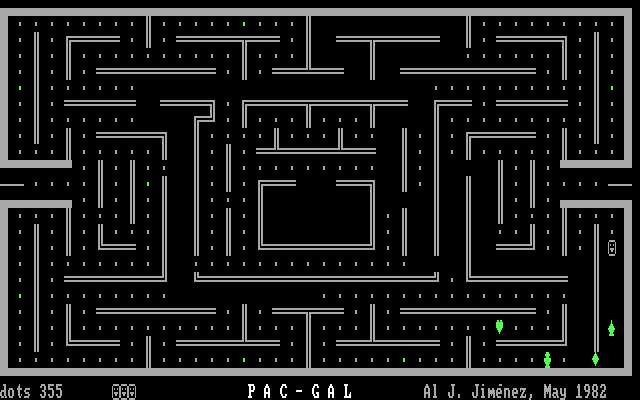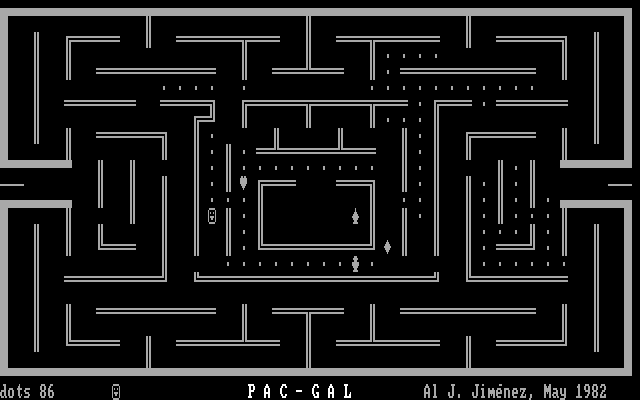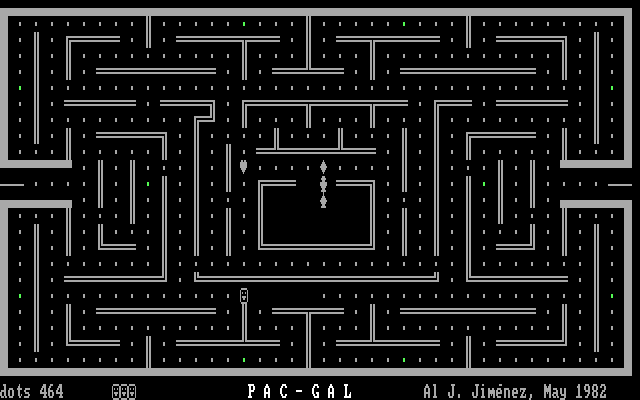Retro Replay Review
Gameplay
Pac-Gal delivers a straightforward yet compelling arcade experience by embracing the core mechanics popularized in the early ’80s. You control a simple square block that navigates a maze filled with 468 pellets, all of which must be consumed to advance to the next round. Each maze layout retains a classic feel, but subtle twists in pellet placement and ghost movement keep the action fresh. The immediate challenge—eating every dot before your four heart-, clover-, diamond- and petal-shaped pursuers catch you—creates a constant tension that will have you on the edge of your seat.
(HEY YOU!! We hope you enjoy! We try not to run ads. So basically, this is a very expensive hobby running this site. Please consider joining us for updates, forums, and more. Network w/ us to make some cash or friends while retro gaming, and you can win some free retro games for posting. Okay, carry on 👍)
One of Pac-Gal’s most notable features is its numerically based speed option. By entering a value from 0 to 30000, you can fine-tune the game’s pace to match your reflexes. Setting the speed to 0 transforms the game into a blistering test of split-second decision making, while higher values slow everything down for a more relaxed strategic approach. This level of customization is unusual for a retro clone and gives players of all skill levels the freedom to tailor the difficulty curve.
Enemy patterns in Pac-Gal feel familiar yet distinct. Each ghost shape has its own movement logic: the heart aggressively homes in on you, the clover patrols wider loops, the diamond uses sudden directional shifts, and the petal stalks your block with sporadic bursts of speed. Learning these patterns is essential for survival, and the game’s consistency means you can gradually master each ghost’s quirks. Over time, you’ll develop strategies to funnel ghosts into choke points, use pellets as distractions, and exploit the corners of the maze.
In addition to the standard maze, Pac-Gal occasionally throws in minor variations—such as opening and closing gates or introducing super-pellets that grant temporary invincibility. These twists are rare but effective at breaking the routine just enough to maintain excitement. Combined with the adjustable speed, the core gameplay loop provides both the simplicity that new players appreciate and enough depth to keep seasoned arcade aficionados coming back for more.
Graphics
Graphically, Pac-Gal embraces a minimalist, retro aesthetic that’s faithful to its inspiration. The mazes are drawn in crisp, single‐pixel lines, and the use of bold primary colors ensures that pellets, walls and ghosts stand out clearly. While the design doesn’t push the boundaries of modern hardware, it doesn’t need to; the clarity and charm of its visuals perfectly capture the spirit of early arcade cabinets.
The ghost shapes—heart, clover, diamond and petal—are rendered with simple geometric precision, yet they possess enough personality to be instantly recognizable. Their contrasting hues (bright red, deep green, royal blue and soft pink) make it easy to track them even in hectic situations. The square player block is equally clear, and its solid color shifting subtly to indicate movement direction helps maintain visibility against the maze background.
Pac-Gal’s UI is kept intentionally sparse. A numeric display in the corner shows the current speed setting and pellet count, but there are no flashy animations or unnecessary overlays to clutter the screen. This stripped-down approach keeps the action front and center, allowing players to focus fully on navigating the maze and outmaneuvering ghosts. The only minor suggestion would be the addition of a small map preview, but even without it, the visual design is well executed.
Overall, the game’s graphics succeed in evoking a nostalgic arcade atmosphere. Bright, uncomplicated visuals, paired with smooth sprite movement, deliver an experience that feels authentic without becoming dated. Whether you’re playing on a vintage monitor or a modern display, the presentation retains its retro charm and readability.
Story
As is typical for games of its era, Pac-Gal doesn’t rely on an elaborate narrative to drive the action. Instead, the “story” unfolds through the gameplay itself: you, the nimble block, must outwit four relentless ghost shapes and clear the maze of pellets. This simple premise harkens back to a time when arcade titles prioritized pure mechanics over cinematic lore.
The lack of a traditional plot actually works in Pac-Gal’s favor, as it places the emphasis squarely on skill development and high score chasing. Each level cleared feels like a small victory in an ongoing personal quest for mastery. Though there’s no cut-scene drama or character backstory to unpack, the sense of progression comes from refining your play style and tackling ever-faster speed settings.
Flavor text is minimal—perhaps a title screen blurb summarizing that you’re “challenging the maze” or a rudimentary game-over screen admonishing you to “try again.” These small touches are enough to give context without distracting from the core loop. If you’re looking for a narrative-driven adventure, Pac-Gal may feel light on story. But if you value pick-up-and-play immediacy and a focus on pure arcade thrills, the pared-down storytelling is a feature rather than a flaw.
In the absence of a conventional storyline, the game’s incremental difficulty and ghost behaviors become the narrative engine. Each new speed setting or level presents fresh obstacles, turning the ghosts’ pursuit into an evolving tale of cat-and-mouse. Pac-Gal tells its story through escalating challenge, and for many players, that’s more than enough to stay hooked.
Overall Experience
Pac-Gal stands out as a faithful, no-frills homage to one of the most iconic arcade games ever made. Its blend of straightforward mechanics, adjustable speed settings and distinctive ghost shapes creates an experience that feels both nostalgic and customizable. Whether you’re a newcomer curious about retro gaming or a seasoned veteran chasing perfection at speed 0, Pac-Gal adapts to your personal play style.
The pick-up-and-play nature of the game makes it ideal for quick sessions on a lunch break, while the challenge of clearing all 468 pellets under pressure provides enough depth for marathon gaming nights. The absence of superfluous menus and the focus on action ensure that each playthrough starts in seconds, letting you dive straight into the maze with minimal fuss.
Some players might miss a built-in level editor or online leaderboards, features that could have extended replay value even further. Yet, the core design—crisp visuals, modular speed control and reliable ghost AI—delivers enough addictive momentum to stand on its own. The game shines when you’re honing your strategies, memorizing ghost patterns and striving for personal bests.
In conclusion, Pac-Gal offers a solid arcade experience that honors its inspiration while injecting just enough modern flexibility to feel its own game. It’s an engaging trip down gaming memory lane, and with its adjustable pace and enduring challenge, Pac-Gal is a worthwhile purchase for anyone who appreciates the pure joy of classic maze-based gameplay.
 Retro Replay Retro Replay gaming reviews, news, emulation, geek stuff and more!
Retro Replay Retro Replay gaming reviews, news, emulation, geek stuff and more!







Reviews
There are no reviews yet.